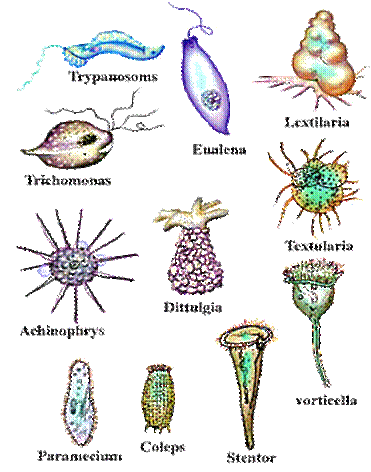Kingdom Protista:
Protista = the very first
all Eukaryotic



Protists belong to the Kingdom Protista, which includes mostly unicellular organisms that do not fit into the other kingdoms.
Characteristics of Protists
They all need some kind of a water-based environment--which can be fresh or marine water, snow, damp soil, polar bear hairs--in which to live. All are aerobic and have mitochondria to do cellular respiration, and some have chloroplasts and can do photosynthesis.
- mostly unicellular, some are multicellular (algae)
- can be heterotrophic or autotrophic
- most live in water (though some live in moist soil or even the human body)
- ALL are eukaryotic (have a nucleus)
- A protist is any organism that is not a plant, animal or fungus
- how they obtain nutrition
- how they move
Plantlike Protists - also called algae - autotrophs
Funguslike Protists - heterotrophs, decomposers, external digestion
The transition to eukaryotic cells appears to have occurred during the Proterozoic Era, about 1.2 to 1.5 billion years ago. However, recent genetic studies suggest eukaryotes diverged from prokaryotes closer to 2 billion years ago. Fossils do not yet agree with this date. The old Kingdom Protista, as I learned it long ago, thus contains some living groups that might serve as possible models for the early eukaryotes. This taxonomic kingdom has been broken into many new kingdoms, reflecting new studies and techniques that help elucidate the true phylogenetic sequence of life on Earth.
http://faculty.southwest.tn.edu/rburkett/kingdom_protista.htm
Protists belong to the Kingdom Protista, which includes mostly unicellular organisms that do not fit into the other kingdoms.
Characteristics of Protists
They all need some kind of a water-based environment--which can be fresh or marine water, snow, damp soil, polar bear hairs--in which to live. All are aerobic and have mitochondria to do cellular respiration, and some have chloroplasts and can do photosynthesis.
- mostly unicellular, some are multicellular (algae)
- can be heterotrophic or autotrophic
- most live in water (though some live in moist soil or even the human body)
- ALL are eukaryotic (have a nucleus)
- A protist is any organism that is not a plant, animal or fungus
- how they obtain nutrition
- how they move
Plantlike Protists - also called algae - autotrophs
Funguslike Protists - heterotrophs, decomposers, external digestion
The transition to eukaryotic cells appears to have occurred during the Proterozoic Era, about 1.2 to 1.5 billion years ago. However, recent genetic studies suggest eukaryotes diverged from prokaryotes closer to 2 billion years ago. Fossils do not yet agree with this date. The old Kingdom Protista, as I learned it long ago, thus contains some living groups that might serve as possible models for the early eukaryotes. This taxonomic kingdom has been broken into many new kingdoms, reflecting new studies and techniques that help elucidate the true phylogenetic sequence of life on Earth.

No comments:
Post a Comment
Note: Only a member of this blog may post a comment.